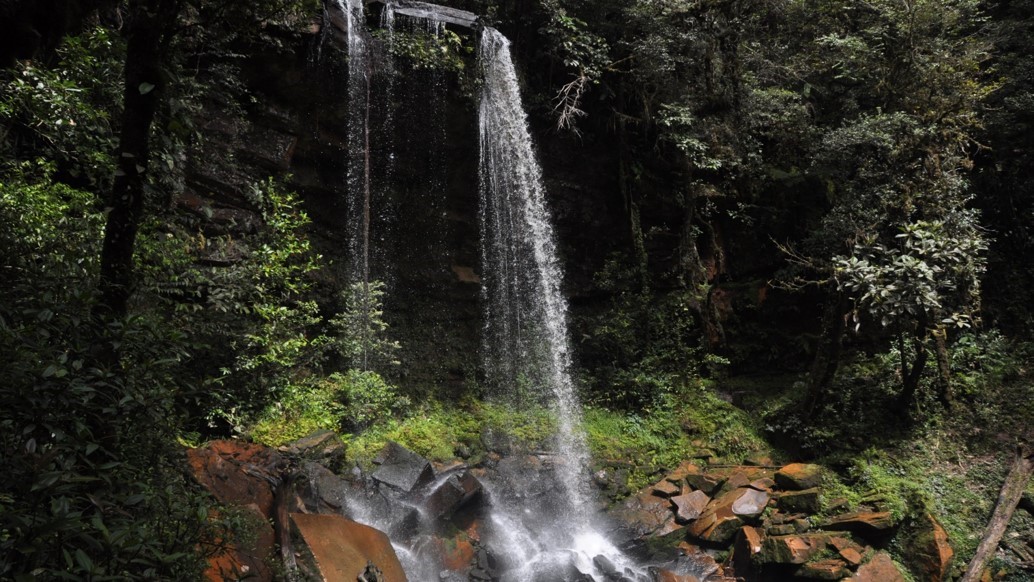Sustainable Forest Management is the management of forests according to the principles of sustainable development. Sustainable Forest Management has to keep the balance between three main pillars: ecological, economic and socio-cultural.
A) Payeh Maga Highland Conservation Project
 Introduction:
Introduction:
Payeh Maga Highland is situated at the highlands of Lawas, Sarawak. The Payeh Maga Highland Conservation Project is a partnership project between UPM and Forest Department Sarawak (FDS). The objective of this project was to explore the biodiversity of the highland forests. The project was headed by Assoc. Prof. Dr Ong Kian Huat. Other researchers participated were Dr. Zamri Rosli, Dr Geoffery James Gerusu & Dr Roland Kueh Jui Heng. UPM through its’ Department of Forestry Science at UPM Bintulu Sarawak Campus (UPMKB) conducted wildlife survey and plant inventory in 2014 and was completed in 2017. This project was funded by FDS amounting to RM 237,002.00 & supported by Syarikat Samling Timber Sdn. Bhd.
 Pictures:
Pictures:
 (The iconic view of Payeh Maga waterfall)
(The iconic view of Payeh Maga waterfall)
 (Chestnut-collared Kingfisher (Actenoides concretus) a common kingfisher)
(Chestnut-collared Kingfisher (Actenoides concretus) a common kingfisher)
 Publication
Publication
 Book
Book
- Z, Rosli, Ong, K.H., Heng, R.K.J., Mang, N.G., Abd. Rahim, S.S., Gerusu, J.G., Allwi, N.I. 2019. Payeh Maga Highland Conservation Area: A pictorial information on Montane Birds Species & Research activities. ISBN: 978-967-12140-2-2

 Journal
Journal
- Heng, R.K.J., Mang, N.G., Ong, K.H., Sait, M., Sam, S., Empin, G.B., Rajanoran, T., Sinus, C.R. 2017. Tree diversity at Payeh Maga Montane Forest, Sarawak, Borneo. Journal of Tropical Biology and Conservation 14: 125-150.
Tree species composition and diversity were determined at 1,600 m Payeh Maga Highland in Lawas, Sarawak, Borneo. Five study plots (20 x 20 m) were established at five transect lines (1 ha). The study shows that the forest was represented by 40 families, 68 genera and 151 species. Fagaceae represented 26 % of the families recorded, followed by Myrtaceae (16 %) and Clusiaceae (12 %) which are a typical family of montane forest in this region. Important Value Index (IV) showed Lithocarpus urceolaris as the most important species (IV=294 %), followed by Gymnostoma sumatranum (IV=273 %) and Tristaniopsis microcarpa (IV=194 %). There are no significant differences among transects for number of species and diversity indices. This forest is important for biodiversity conservation as it is as rich as those reported for lowland forests elsewhere in this region. The continued accumulation of species is an indication that this highland could support and provide habitat for larger tree species communities.
- Laing, R.S.L., Ong, K.H., Heng, R.K.J., Mang, N.G., Hung, P.K.J., Sait, M. 2019. Stand structure, floristic composition and species diversity along altitudinal gradients of a Bornean mountain range 30 years after selective logging. Journal of Mountain Science 16(6): 1419-1434
The mountain ecosystem is a hotspot of biodiversity and provides a significant contribution to the humans' livelihoods. However, there is still a lack of information regarding floral diversity and how it has been affected due to a logging operation in Sarawak. A study was conducted to determine vegetation recovery at the Heart of Borneo conservation area at different elevations: 750–1200 m (S1), 1200–1500 m (S2) and >1500 m (S3).A total of 891 trees were enumerated. The trees comprised 55 families, 98 genera and 203 species. The lowest elevation site, S1, contained the highest number of species (117) and families (42), while the highest elevation site, S3, contained the lowest diversity (25 families and 59 species).A similar forest structure was recorded, whereby diameter at breast height (dbh), basal area and height decreased as elevation increased. The most speciose families in S1 were Dipterocarpaceae (11 species) and Lauraceae (10 species),while Lauraceae and Fagaceae were the dominant tree families at S2 and S3.Secondary tree species are still abundantly found in the logged plots, especially at S2 (45.5%), indicating that after 30 years, these stands are still in the recovery stages. The logged plots retained typical secondary forest appearances with lower canopy diameters and heights and dbh than the unlogged forest. Although the species richness approached that of the unlogged plots, especially at S1 (90.9%) and S3 (94.9%), there were still major differences in the floristic compositions between logged and unlogged plots (35.4%, 21.5% and 44.7% for S1, S2 and S3,respectively).Although potential seed sources were in close proximity, succession at S2 has proceeded much slower than at S1 and S3.Lower concentrations of soil nutrients, especially N, may be the main reason for the slow recovery .In conclusion, the results suggested that the selectively logged forest at the Payeh Maga Highland
 For more further enquiries:
For more further enquiries:
Assoc. Prof. Dr. Ong Kian Huat
Senior Lecturer
Department of Forestry Science
Faculty of Agricultural Science and Forestry
Tel: +6086 855203
Email: okhuat@upm.edu.my
Updated:: 08/02/2024 [lanz]
MEDIA SHARING











 Introduction:
Introduction: Pictures:
Pictures: (The iconic view of Payeh Maga waterfall)
(The iconic view of Payeh Maga waterfall) (Chestnut-collared Kingfisher (Actenoides concretus) a common kingfisher)
(Chestnut-collared Kingfisher (Actenoides concretus) a common kingfisher) Publication
Publication  Book
Book
 For more further enquiries:
For more further enquiries:


















